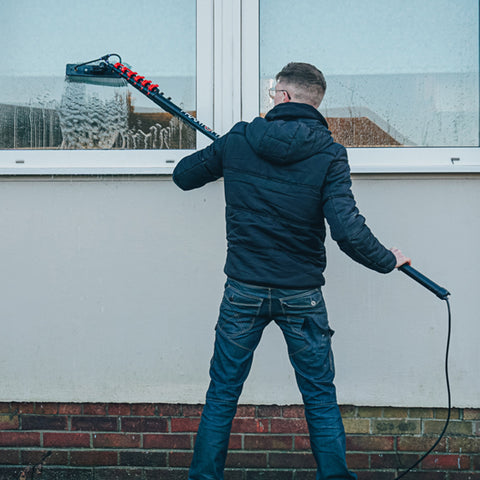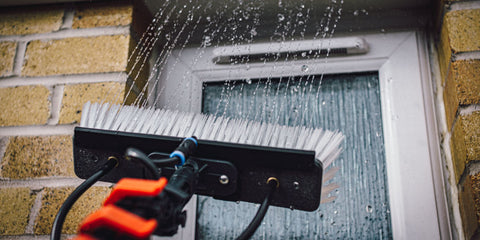What is Pure Water Window Cleaning?
The term 'Pure Water' in window cleaning describes ordinary tap water that has been filtered through a purification system to remove all the natural minerals. This water is often described as ‘deionised water’ due to the type of filtration used. The reason for this, is that pure water dries to leave a completely crystal clear finish.
If you've ever thought, 'Why do Window Cleaners not dry the windows?' Here's why; when applied to Window Cleaning, using pure water means that there is no need to squeegee the water from the window. Providing you have agitated (or scrubbed) the dirt and rinsed the window thoroughly to remove the dirt, you can leave it wet and it will dry completely clear!
Pure Water Systems come in varying capacities, from many different brands & to fit any need & budget (find out more about the types of filtration)
Here’s a brief overview of how the pure water Window Cleaning process works:
1) Agitating the Dirt
Once water is purified, it is ready to clean with. However, it’s not just a case of ‘splash & dash’, there is some know-how required. The first step is to agitate (scrub) the windows with a water-fed pole & brush designed specifically for the task. By scrubbing the windows, you’re loosening any dirt or build up on the window, frame and surrounding plastics.

2) Effective Rinsing
Rinsing the loosened dirt and debris is important, as anything except pure water left on the window will ruin the perfect finish. The deionised water will attract the dirt and minerals scrubbed from the window, creating a non-pure solution. This needs to then be rinsed thoroughly from the window, leaving only pure water left to dry clear in a matter of minutes (the same applies to sills and frames). Best practice is generally to begin at the top, and rinse down the window going left to right to ensure everything is removed.
It’s simple in principle, though of course like anything, there is a learning curve and it will take time to become completely proficient in this method of cleaning.

Pure Water Window Cleaning is becoming increasingly popular for the following reasons:
- No Need for Ladders - Pure Water Window Cleaning can be carried out at height, from the ground
- Accessibility - reach over awkward obstacles, clean uPVC plastic frames and sills from the ground
- Environmentally Friendly - effective cleaning without chemicals or soap
- Safer Work Environment - less risk of property damage
- Added Privacy - the customer need not worry about being visible through upstairs windows!
For aspiring commercial Window Cleaners, the added safety benefit of cleaning from the ground is an excellent selling point, and even a requirement for some buildings.
Regardless of your preferred method of cleaning Windows, the smart modern Window Cleaner will have a means to utilise purified water, even if it is not the primary method of cleaning.
What is Pure Water?
In addition to Hydrogen and Oxygen (H₂O), tap water also contains minerals. For drinking purposes, this isn’t a problem. However, when it comes to cleaning, the likes of calcium, magnesium, and other minerals remain when the water evaporates away. This leaves hard water stains and unsightly spotting. You’ll notice these build up on any glass surrounding showers or taps at home, or even after washing your car.
Generally, water is classified as either hard or soft. This refers to the amounts and types of minerals built up in the water. The harder the water, the more costly it is to purify, and this is usually location-dependent. For example, in the UK, most of South Wales & Scotland have soft water- TDS meter readings of 150 ppm or less- whereas Bristol and London typically have hard water at 350-500 ppm in places.
How Do I Test Water Purity?
You can test your tap water with a TDS Meter which measures electrical conductivity and produces a value indicating the level of dissolved solids (minerals) in the water. For window cleaning purposes, a value of 000 ppm (parts per million) of dissolved solids is considered pure and will produce a streak and spot free finish on the glass. It’s reasonable to effectively clean windows with readings of 0-7 ppm, though this is just a rule of thumb, you may be able to clean with readings higher than this depending on what specifically is in your water. Trial and error will help you determine where the line is drawn.
HM Digital produces high-quality TDS meters. You can pick one up Here
Where To Go Next
Head to our Starting a Window Cleaning Business Hub for more helpful guides, or check out these popular articles:
It's Important to consider how you’re going to purify water:
RO/DI or DI Only - Types of Filtration Explained


